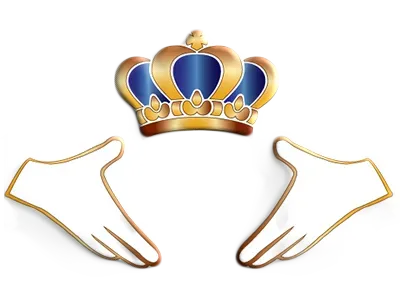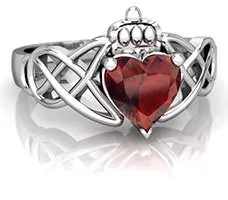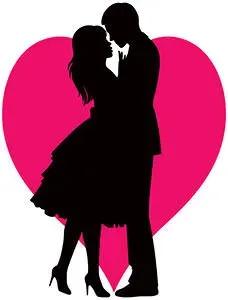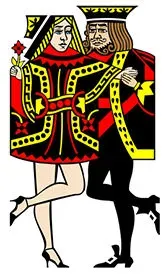 The claddagh is an ancient Gaelic symbol that consists of two joined hands holding a heart with a crown over it and has traditionally symbolized eternal love, everlasting friendship and loyalty. It belongs to a family of European rings called Fede rings, or faith rings. Fede is derived from Italian "mani in fede" or hands (joined) in faith. These rings portray two hands clasped together symbolizing faith and trust, and were used as engagement or wedding rings dating back to the Roman Empire as well as in medieval and Renaissance Europe. The claddagh is a variation of the earlier version of a Fede ring.
The claddagh is an ancient Gaelic symbol that consists of two joined hands holding a heart with a crown over it and has traditionally symbolized eternal love, everlasting friendship and loyalty. It belongs to a family of European rings called Fede rings, or faith rings. Fede is derived from Italian "mani in fede" or hands (joined) in faith. These rings portray two hands clasped together symbolizing faith and trust, and were used as engagement or wedding rings dating back to the Roman Empire as well as in medieval and Renaissance Europe. The claddagh is a variation of the earlier version of a Fede ring.
 The modern claddagh ring's distinctive design originated in Ireland over 400 years ago. Claddagh comes from the Irish word Cladach, meaning "the shore", since it originated from one of the oldest ever recorded fishing villages outside the city walls of Galway, Ireland. Local fishermen utilized the Claddagh crest on their ships and sails for identification purposes. Whoever did not have that symbol was chased away or killed to prevent other fishermen from fishing in their waters. It became known as a symbol of "Fisher Kings" of the Galway village of Claddagh, Ireland.
The modern claddagh ring's distinctive design originated in Ireland over 400 years ago. Claddagh comes from the Irish word Cladach, meaning "the shore", since it originated from one of the oldest ever recorded fishing villages outside the city walls of Galway, Ireland. Local fishermen utilized the Claddagh crest on their ships and sails for identification purposes. Whoever did not have that symbol was chased away or killed to prevent other fishermen from fishing in their waters. It became known as a symbol of "Fisher Kings" of the Galway village of Claddagh, Ireland.
 In a typical claddagh ring, the heart represents love, the joined hands represent friendship and trust, and the crown represents loyalty/fidelity. The circular nature of the ring is thought to represent eternity. A cross may be added to the design to represent faith, or a birthstone may further personalize this timeless keepsake. In a Christian tradition, the heart with the crown over it represents God the Father and the two hands stand for Jesus and the Holy Spirit. According to an ancient Celtic legend, the right hand in the claddagh symbol represents Dagda, the Father of all Celtic Gods; the left hand represents the ancestral mother Goddess Anu; the crown represents Beathauile, the universal spirit of the Celts, and the heart represents the heart of all mankind.
In a typical claddagh ring, the heart represents love, the joined hands represent friendship and trust, and the crown represents loyalty/fidelity. The circular nature of the ring is thought to represent eternity. A cross may be added to the design to represent faith, or a birthstone may further personalize this timeless keepsake. In a Christian tradition, the heart with the crown over it represents God the Father and the two hands stand for Jesus and the Holy Spirit. According to an ancient Celtic legend, the right hand in the claddagh symbol represents Dagda, the Father of all Celtic Gods; the left hand represents the ancestral mother Goddess Anu; the crown represents Beathauile, the universal spirit of the Celts, and the heart represents the heart of all mankind.
 Although there are many legends as to the origins of the claddagh ring, the most popular one involves a man by the name of Richard Joyce who left his true love in Galway to seek a fortune in the West Indies. His ship was captured by pirates enroute to his destination and he was sold into slavery to a Moorish goldsmith. It was there that he learned the craft of jewelry making, becoming a master craftsman and earning the admiration of his master. In 1689, when all slaves were freed following King William III's decree, Joyce's master offered him his own daughter's hand in marriage and a sizable dowry of half of all his wealth. Joyce refused, and returned to Ireland, where his love was still waiting for him. He brought with him the claddagh ring that he painstakingly designed while living for 14 years in captivity, hoping to one day present it to his love. They got married and he became the town's local goldsmith. Even today, one of the earliest claddagh rings has his initials on it.
Although there are many legends as to the origins of the claddagh ring, the most popular one involves a man by the name of Richard Joyce who left his true love in Galway to seek a fortune in the West Indies. His ship was captured by pirates enroute to his destination and he was sold into slavery to a Moorish goldsmith. It was there that he learned the craft of jewelry making, becoming a master craftsman and earning the admiration of his master. In 1689, when all slaves were freed following King William III's decree, Joyce's master offered him his own daughter's hand in marriage and a sizable dowry of half of all his wealth. Joyce refused, and returned to Ireland, where his love was still waiting for him. He brought with him the claddagh ring that he painstakingly designed while living for 14 years in captivity, hoping to one day present it to his love. They got married and he became the town's local goldsmith. Even today, one of the earliest claddagh rings has his initials on it.
 Another mythical legend involves a woman named Margaret Joyce, who inherited a huge fortune from her late husband Domingo de Rona, a wealthy Spanish merchant who used to trade with Galway. She used all her money to build bridges and for other charitable events in Western Ireland, instead of spending it on herself. To reward her for her compassion, an eagle dropped an original claddagh ring on her lap.
In the 17th century, a claddagh ring became a traditional Irish engagement or wedding heirloom, and was passed down from mother to daughter or from a grandmother to a granddaughter on her wedding day. Other times, it was passed down whenever the mother or grandmother would decide their daughter or granddaughter was ready to accept such a meaningful, deeply rooted in tradition gift. Alternatively, a groom would place it on his bride's finger on the day of their engagement, cementing his love and loyalty to her with the following words, "With these hands I give you my heart and I crown it with my love."
Another mythical legend involves a woman named Margaret Joyce, who inherited a huge fortune from her late husband Domingo de Rona, a wealthy Spanish merchant who used to trade with Galway. She used all her money to build bridges and for other charitable events in Western Ireland, instead of spending it on herself. To reward her for her compassion, an eagle dropped an original claddagh ring on her lap.
In the 17th century, a claddagh ring became a traditional Irish engagement or wedding heirloom, and was passed down from mother to daughter or from a grandmother to a granddaughter on her wedding day. Other times, it was passed down whenever the mother or grandmother would decide their daughter or granddaughter was ready to accept such a meaningful, deeply rooted in tradition gift. Alternatively, a groom would place it on his bride's finger on the day of their engagement, cementing his love and loyalty to her with the following words, "With these hands I give you my heart and I crown it with my love."
 In the mid-19th century, as Ireland was plagued by the Great Famine, thousands fled their country to avoid death and arrived in the United States. The claddagh ring was sometimes the only piece of jewelry the Irish immigrants owned and were able to bring with them to the United States and Canada. That is how the popularity of the claddagh ring spread and it eventually became a symbol of Irish culture all over the world.
Today, a claddagh ring can be given as a token of friendship or love, or as a source of pride in one's Irish heritage. The claddagh ring can be worn in different ways to signify different relationship statuses. Wearing it on the right hand with the heart facing out, away from the body, means one's heart is open and looking for love. Wearing it on the right hand with the heart facing in towards the body means the one's heart has already been captured, and that one may be in a relationship. Wearing it on the left hand with the heart facing in means one is married, or has joined her heart with another forever.
In the mid-19th century, as Ireland was plagued by the Great Famine, thousands fled their country to avoid death and arrived in the United States. The claddagh ring was sometimes the only piece of jewelry the Irish immigrants owned and were able to bring with them to the United States and Canada. That is how the popularity of the claddagh ring spread and it eventually became a symbol of Irish culture all over the world.
Today, a claddagh ring can be given as a token of friendship or love, or as a source of pride in one's Irish heritage. The claddagh ring can be worn in different ways to signify different relationship statuses. Wearing it on the right hand with the heart facing out, away from the body, means one's heart is open and looking for love. Wearing it on the right hand with the heart facing in towards the body means the one's heart has already been captured, and that one may be in a relationship. Wearing it on the left hand with the heart facing in means one is married, or has joined her heart with another forever.
 The popularity of a claddagh ring is widespread. British royals such as Queen Victoria, Queen Alexandra, King Edward the VII, and George V all owned claddagh rings, as well as Princess Ranier and Princess Grace of Monaco. On the American side, John F. Kennedy and his wife Jackie were proud wearers of the claddagh ring, which they acquired on their trip to Galway, Ireland in 1963. Ronald Reagan and world renowned actress Grace Kelley were rumored to wear claddagh rings also. Hollywood further popularized the claddagh ring, by making it part of a plot in their recent TV series "Buffy the Vampire Slayer". Following the 2001 attacks on the Twin Towers in NYC, more than 200 claddagh rings were found amongst the wreckage, testifying to the everlasting popularity of the claddagh, as it transcends time and generations, linking past to the present.
The popularity of a claddagh ring is widespread. British royals such as Queen Victoria, Queen Alexandra, King Edward the VII, and George V all owned claddagh rings, as well as Princess Ranier and Princess Grace of Monaco. On the American side, John F. Kennedy and his wife Jackie were proud wearers of the claddagh ring, which they acquired on their trip to Galway, Ireland in 1963. Ronald Reagan and world renowned actress Grace Kelley were rumored to wear claddagh rings also. Hollywood further popularized the claddagh ring, by making it part of a plot in their recent TV series "Buffy the Vampire Slayer". Following the 2001 attacks on the Twin Towers in NYC, more than 200 claddagh rings were found amongst the wreckage, testifying to the everlasting popularity of the claddagh, as it transcends time and generations, linking past to the present.